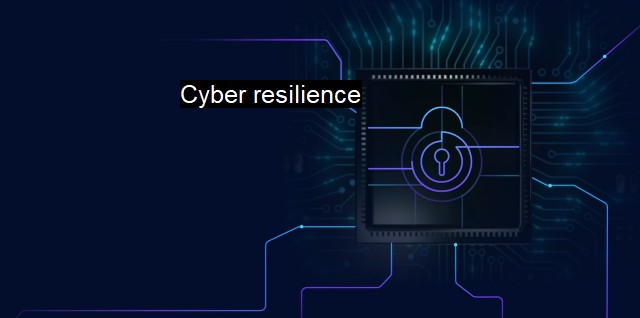What is Cyber resilience?
The Importance of Cyber Resilience: Building a Culture of Protection and Recovery in the Digital Age
Cyber resilience is a crucial concept within the realm of cybersecurity that pertains to an organization's ability to continue carrying out its business obligations by protecting against, defending, recovering, and swiftly learning from diverse security-related incidents. It mainly focuses on identifying infrastructural weaknesses, preparing for possible cyber threats, maintaining operations during the threat and displaying adaptability, and continuous learning and improvement after an attack has occurred.Donned originally from the system theory, resilience refers to an entity's capability to have its form restored after being altered. Applying this phenomenon in terms of cybersecurity brings about the general idea of Cyber Resilience. In simpler terms, this is just the effort of an organization to sustain its operations regardless of a potential or actual cyber attack. There's an emphasis on several areas including integrity, speed, discretion, and resilience within software systems, network framework, and data storage facilities.
Cyber resilience isn't just about building a solid protective wall against cyber threats, but also about the capacity to recover from cyber attacks or system errors and to decrease the possible downtime and its aftereffects. It extends beyond basic digital details and focuses on the influence that digital events may have on the relative organizational aspects - working procedures, infrastructure, individuals, and the total impact on the company's bottom line. It helps organizations to prepare for, detect, respond, and recover from complicated inter-networked system threats that may otherwise disrupt momentous business operations.
It is important to draw a line between cybersecurity and cyber resilience. While cybersecurity focuses on defending an organization from cyber threats, cyber resilience recognizes that cyber threats are unavoidable and inevitable. Thus, it ensures an organization is ready not only to defend against these disturbances but also to operate during the disturbance and recover from it rapidly and efficiently.
A critical discipline within the wide architectural area highly related to cyber resilience is antivirus software. Antivirus protection becomes part of a cyber resilient architecture as the fundamental layer of defense to fight malicious programs. Fundamental antivirus programs are evolving to comprehensive security suites. These cybersecurity packages aim to pinpoint and eliminate various threats like malware, spyware, ransomware, and phishing attacks.
Software patches used by antivirus programs are particularly important when considering cyber immunity because they fix weaknesses that hackers often exploit. Maintaining a system that is up-to-date includes timely antivirus software updates that pose a valuable component. Having antivirus as part of your holistic defense approach, a cornerstone in a much larger cyber resilience strategy, is an effective way of safeguarding individual users and companies.
A collateral benefit of focusing on cyber resilience is the fact that due to post-incident reviews, analyses, and improvements, systems become more robust and quite resilient in the face of threats. Such exercises become a blessing in disguise, disguising itself as potential threats causing organizations to address systemic issues early and reinforce overall security.
Undeniably, cyber resilience is fundamental for operations consistency. With businesses increasingly transitioning to digital platforms, information security continues to swell in prominence. We can define this dynamic world of cyber resilience as an ecosystem where robust cybersecurity measures like firewall protection, secure network design, monitoring controls, antivirus software, and data encryption techniques all work together in harmony to identify, protect, detect, recover, and learn quickly and efficiently.
Cyber resilience revolves around more than just surviving after a security incident has occurred. It's an opportunity for growth, learning, and development. The process provides organizations with unique insight into their operation, significant leakage points, and learning experiences, increasing all levels of business's cyber protection. Committing to strong cyber resilience is more than just a defensive strategy—it's a wise business strategy to thrive in the digital age.

Cyber resilience FAQs
What is cyber resilience?
Cyber resilience refers to an organization's ability to withstand, adapt to, and recover from cyber threats and attacks in order to continue its normal operations. It involves identifying potential threats, implementing proactive measures to prevent them, and being prepared to respond effectively in case of a breach.How does cyber resilience differ from cybersecurity?
While cybersecurity focuses on protecting networks, devices, and sensitive data from unauthorized access, cyber resilience goes beyond that by incorporating strategies to recover from an attack and resume normal operations. Cyber resilience includes measures such as backups, disaster recovery plans, and incident response plans to minimize the impact of cyber attacks.What are some best practices for building cyber resilience?
Some best practices for building cyber resilience include continuously updating software and security measures, implementing multi-factor authentication, conducting regular training and awareness programs for employees, creating backups and disaster recovery plans, and conducting regular security risk assessments.Why is cyber resilience important for businesses and organizations?
Cyber resilience is important for businesses and organizations because cyber attacks can cause significant damage to reputation, finances, and operations. In addition to the cost of repairing damage caused by a breach, organizations may also face legal and regulatory fines and penalties. By implementing cyber resilience strategies, businesses and organizations can minimize the impact of cyber attacks and ensure continuity of operations.| | A | | | B | | | C | | | D | | | E | | | F | | | G | | | H | | | I | | | J | | | K | | | L | | | M | |
| | N | | | O | | | P | | | Q | | | R | | | S | | | T | | | U | | | V | | | W | | | X | | | Y | | | Z | |
| | 1 | | | 2 | | | 3 | | | 4 | | | 7 | | | 8 | | |||||||